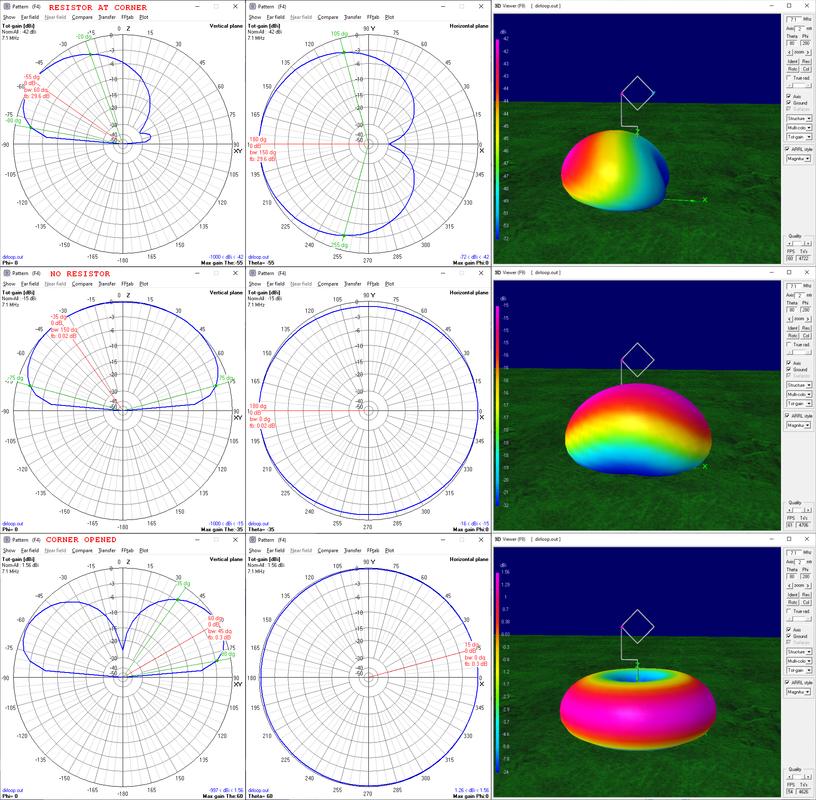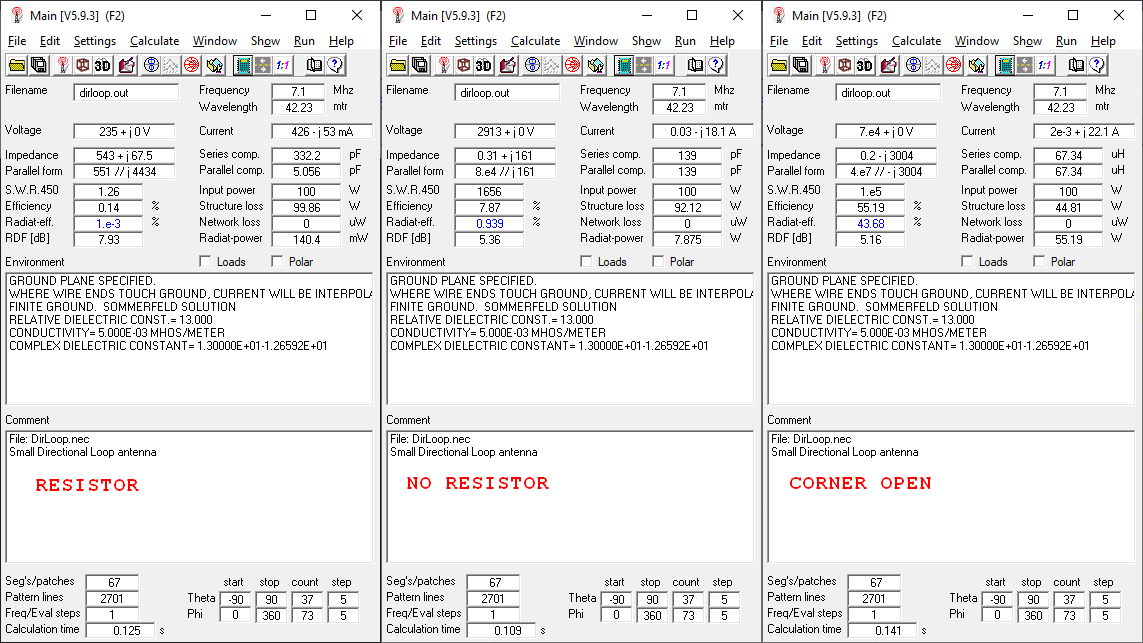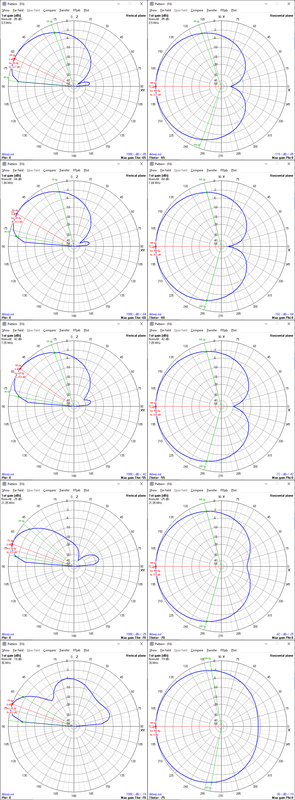13dka wrote: ↑Wed Jul 27, 2022 2:51 pm
What I described earlier is this:
Yes, that's another possible way to arrange the loop, I just wonder if the additional complexity when it comes to deploying or dismantling the antenna, for portable use, may be worth
Sorry for being sceptical - I'm not quite sure if that's always practical or desirable, if that's even possible at all. For example if the noticeable minimum is traded in for a narrower lobe, it will be harder to find the direction of a signal using the sharp minimum while it will be still hard to find it using the maximum and having these minimums is certainly a valuable asset (think pinpointing QRM sources by walking around, this antenna is still quite lightweight and handheld-portable). Having both at the same time might be a really tall order.
Probably you're right and I'm just trying to "chase ghosts" here, all in all the SDL is pretty good at what it does, the only drawback is that due to its small size and the resistor its gain is pretty low, but even then, judging from your tests it seems to be a nice choice for people w/o too much available space; also, I've been fiddling a lot with NEC model variations but had no real improvement, the only thing I didn't try (yet

) is flipping the loop horizontally so, in practice, turning it into a "mini rhombic" antenna, I think I'll give the idea a spin, just for curiosity

BTW, the limits of the NooElec LANA HF could indeed be an issue. I have previously tried it with the 20m LoG and it reacted with intense intermodulation to the partially not so small signals on 49/41/31m. Not a problem with the YouLoop but with the SDL I can see very faint beginnings of intermodulation in the otherwise dead VLF range only. When I saw this I checked said bands for big signals from the usual suspects but there wasn't anything really big, so maybe that was caused by something on FM or elsewhere.
In own experience, here in EU the FM stations are the culprit for a lot of IMD issues, and if you consider that the LANA HF works up to 150MHz, it's more than possible that some FM signals overload it causing the issue; as a note, I had to buy an FM bandstop filter time ago since some of the SDR units I was testing shown "ghost" images due to overloading from FM stations <deep sigh>
Exactly. It could retain as much benefits of regular SMLs as possible while doing away with their worst disadvantages, which would make them the closest thing to a...

Nay, I don't think it's a miracle, just a small loop with some tweaks
I compared it with the YouLoop indoors of course -- the shielded design does have some advantages in that quite extremely noisy place and the 2-turn Moebius trick gives it great properties on MW. This advantage disappears - typical for SMLs - at the latest above 10 MHz and what gives the YouLoop the edge below is probably mostly its sharp and deep nulls. What I want to say is that the SDL could even be a better indoor option for shortwave in many cases where the local QRM is less extreme and diverse and if the room is not on the 23rd floor of a high-rise but most likely it may be a better option than any SML in a backyard, terrace or balcony indeed. Of course, whether or not it actually is "better" depends on a lot of factors, for example, do you even play radio at a time of day when this antenna could play its winning cards etc.
As for physical height vs "electrical" one, my bet is that installing the SDL on a terrace at the 23rd floor and on a 3m pole will still give a pattern similar to the one of the antenna sitting at 3m from ground, at least if we consider that the floor of that terrace usually contains metallic net and/or metal bars, so the antenna will "see" it as the ground (plane)
Andrew (grayhat) wrote: ↑Wed Jul 27, 2022 7:31 am
Well, I don't think "miracle antennas" exist, so... well, this one seems to work decently well (note: Thomas saw that Radio Romania VS BBC video and wrote "That is INSANE! Most impressive!" and also "I look forward to an article that might not only help others built, but also use one"

) and may help (or at least that's the hope) many SWLers and Hams

Yes, so far it looks really promising to me, not only for application in noise- or space-restricted cases , I hope I finally get to compare it directly with LoG and SML this weekend (though summer break in all federal states now may get in the way of that, I can't have a whole bunch of RVs around, disturbing me and the antenna patterns grrr) to verify its benefits over these antennas. A draft for an article is already in the making, I have like 1000 words so far.

COOL, I was thinking to ask if you'd like to put something together, also since I'm not so good at writing documentation or the like; oh, by the way, I never meant to "make money" or whatever with this antenna, it's just an idea, but if you think you may earn something, absolutely go for it, the design is public and free, anyone willing to can use and abuse it

One thing the article presenting this antenna should make very clear is what to expect from this antenna, staying away from any kind of hype. That's what I meant by "the antenna works as expected if your expectations are reasonable". Most people reading that may have zero first-hand experience with beams (like yours truly) that were not made for TV reception and may be disappointed otherwise, but even if they have.... the minimum on the backside is not what a Yagi-style beam would have to begin with, but its existence doesn't mean it will make signals disappear. I want to make sure that people understand that this won't work like a flashlight, that 3 S-units difference mean nothing on an S9 station and that the null is not a null most times, even if it looks like that.
Totally, absolutely agreed, as I wrote I don't think it's a "miracle", and presenting it as the "final solution to all SWL evils" would be a very bad idea, it's a honest antenna presenting some peculiarities and which may improve reception; as for the "null" (notice the quotes) I know that it isn't a "total canceller" (although the BBC vs SSR shows pretty well how it works

)


